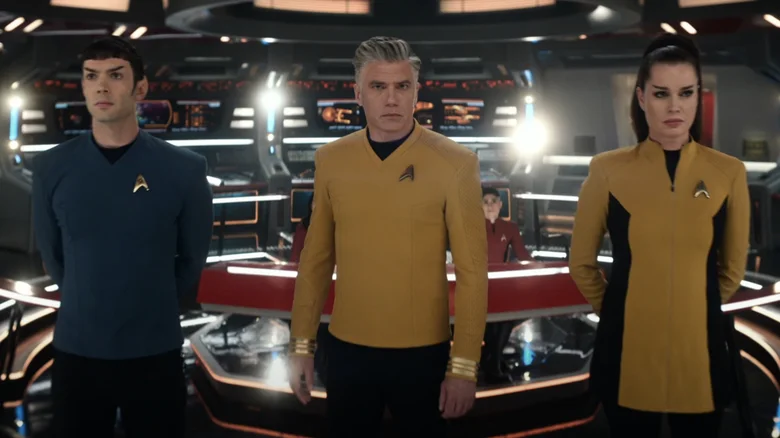I recently rewatched Strange New Worlds, in prep for the new season, this time watching it with my son (his first time). The series is well regarded (the average episode rating is 7.9, compared to 7.7 for TOS’s best season), optimistic, and embraces episodic television, covering a wide range of genres. That said, the series does suffer from prequelitis, repeating those problems common to prequels. Here are four types of issues that I noticed.
Continuity Issues
Prequels often struggle to maintain consistency with the established lore, characters, and events of the original story.
In SNW, the interiors make the Enterprise a much different ship. In TOS, the ship is cramped, with narrow corridors and small rooms. In SNW, in contrast, the bedrooms are luxury suites or apartments, Sickbay has two floors and its own transporter, and the cargo bay is huge. These changes are due to difference in budget and special effects, so I forgive them as differences in staging.
This was something that another prequel, Enterprise (the show), did right, with a ship that looked like a predecessor ship: grappling hooks instead of a tractor beam, a small supply transporter, smaller shuttles, a kitchen rather than food synthesizers, etc. (Even the uniforms looked like they were from an earlier era.)
In SNW, another example of a continuity issue is the Gorn, who are so drastically different from the TOS Gorn that they seem like another species altogether.
Lack of Surprise or Suspense
Since prequels often explore events that are already known or hinted at in the original story, the element of surprise or suspense may be missing.
The first SNW episode is about Pike depressed about his foreseen fate (thanks “Klingon time crystals”, among the dumbest three words ever said in Star Trek), an arc that will persist throughout the season. (I think his foreknowledge only exists because Pike was conceived as a character with a story arc within Discovery, with no thought of him becoming so popular that there would be a spinoff. Had they realized, they might not have had him see his future.)
The second episode is about Cadet Uhura thinking of leaving Starfleet. Wow, I’m on the edge of my seat. I bet she will.
The third episode Samuel Kirk appears to be killed. I’m not too worried. Literally his only scene in TOS is his death scene!
(In SNW’s defense, it did up the ante and kill a beloved new character, much to viewers’ surprise and dismay.)
Overreliance on Fan Service
Prequels may prioritize fan service and references to the original story over delivering a compelling narrative in its own right. This can force contrived connections, callbacks, or cameos that feel disconnected.
There’s a joke about Samuel Kirk’s mustache which is a deep cut. (Shatner wearing a mustache played the corpse of his brother in TOS.)

Keith Wilson writes, “ST: Strange New Worlds is the Star Trek to appease and appeal to those Star Trek fans who can’t accept the New Trek and need to take those old albums off the shelf and listen to them one more time because that new music just isn’t music anymore.”
The producers felt the need to include characters like Uhura (as a cadet), Christine Chapel, M’Benga (who was only in two episodes of TOS), and Una (ditto), rather than invent more new characters. Heck, one of the new characters is related to Khan. It’s fine bit of fan service, I guess, but I would have been happy with more new characters.
Filling in Unnecessary Gaps
Sometimes prequels attempt to provide explanations for every aspect of the original story, even when it’s not necessary or relevant.
In episode 1, “General Order One” gets renamed the “Prime Directive” because of Pike’s interference in another culture. That was a name change that happened in TOS but no one needed how it occurred to be documented.
But, then, did anyone need to see Princess Leia get her signature hair style in Kenobi?!
To Be Continued
Hollywood’s first prequel, The Golem: How He Came Into the World, dates back to 1920! So these prequel tropes have had plenty of time to develop.
Strange New Worlds is a great show, and my hope is that for the second season it tries harder to avoid prequelitis.
Update: In the first episode of season 2, a new character in season 2 knew and was close to Spock’s mother. It’s a small universe after all. And Christine almost dies, in yet another bit of false suspense. And a character gets a canonical prop for the first time, in a rather unlikely way. Later episodes only further lean into prequelitis. The show’s concept is clearly “The Original Series: The Prequel”. Perhaps it should have been named Familiar New Worlds!
Photo by Paramount on StarTrek.com.


